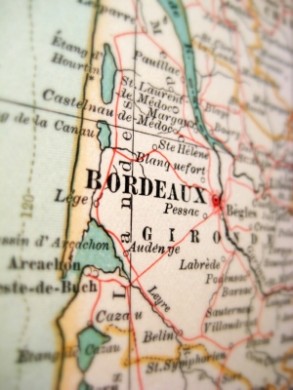Bordeaux Wine Region: Good Times and Great Wines

Bordeaux Wine Region- Day Two
Post written by Jeremy Howard
Our second day in the Bordeaux wine region started with a trip north to St Estephe and the unclassified Chateau Haut-Marbuzet.
- This winery, which dominates the tiny hamlet of Marbuzet, is something of an enigma. It sits on the same escarpment which joins Chateau Montrose with Chateau Cos d’Estournel, which are both Second Growths and which both border the property. The terroir would appear heaven sent, and yet the wine was not classified even Fifth Growth in 1855. I was interested to find out why.
- We were met by the charming and friendly Bruno Duboscq, son of the present owner. He gave us a tour of the not quite state of the art wine making facilities at the property. Although a lot of money had clearly been spent on the outbuildings, some of the equipment clearly had further room for improvement.
- We got down to the business of tasting some wine. Chateau Mac Carthy is the second wine of the estate, and is so named after the Irish family who owned the property in the Nineteenth Century. It is made from the younger vines of the estate. Chateau Mac Carthy 2006 was pretty backward and austere. Aside from some vanilla and gripping tannins I couldn’t find a lot more going on in the glass – 84 points.
- We then moved up to Chateau Haut-Marbuzet 2006. This blend of 50% Cabernet Sauvignon, 40% Merlot and 10% Cabernet Franc was a lot more successful. The nose was floral and complex, with forest floor/undergrowth aromas. It was a powerful St Estephe in the mouth, interesting with good savory grip. The tannins were a little chewy but a good length showed some promise for the future. I quite liked it, and scored 89 points.
- We also tried Chateau Haut-Marbuzet 2004, although for me this was less successful than the 2006. A little hint of roasted meats on the nose was about all I got from the glass; and in the mouth the wine, while more feminine and less extracted than the 2006, nevertheless lacked personality and interest – 86 points.
I left the estate wondering about its potential and about the gap (if any) between the wine being made there at the moment and the best possible wine that the terroir could offer. Significant investment had clearly been made, but my over-riding impression was of a ‘work in progress’. I look forward to a return visit in ten years.
As our hotel base in Paulliac is owned by the Cazes family of Chateau Lynch Bages it seemed rude not to pay an unscheduled visit to chateau itself, which our ever resourceful guide Wendy squeezed in next.
- The tour is a good one, although more in the polished and professional style of Mouton Rothschild.
- The bottling facilities (all of the wine produced at Lynch Bages is bottled using the chateau’s own bottling plant) were especially impressive. In the tasteful tasting room (adorned with African modern art) we first sampled Chateau Haut Bages 2001. An interesting nose of hickory smoke and cut grass made way for a delicious fruit driven forward palate. There was some complexity although red fruits dominated. Not classic Paulliac by any means, with a distinct absence of the power, but good and drinkable. 88 points.
- Chateau Lynch Bages 2001 was a step up in class. A big powerful Paulliac nose of black fruits, tar, smoke and saddle leather. In the mouth the wine was not a barnstormer. I had the pleasure of drinking the 1989 a couple of weeks before and it had none of the ‘shock and awe’ power that the ‘89 possessed. But it had a good acidic backbone and restrained tannins, plus great length. I noted dark black fruits and integrated oak. The only criticism I had was a slight lack of complexity. 92 points.
We had lunch in the beautifully restored little courtyard adjacent to Lynch Bages. At a nearby table sat Lilian Barton Sartorius, the daughter of the famous Anthony Barton, who is now responsible for running much of Leoville and Langoa Barton.
It had been a long day, and I was looking forward to dinner at a chateau that personifies ‘up and coming’ in Bordeaux.
- Third Growth Haut Medoc producer Chateau la Lagune has been the beneficiary of some serious investment since it was acquired by the Frey family in 2000. Not only has the chateau itself been restored in immaculate detail, but the cellar was also completely re-built in 2003. The money has not been wasted.
- With dinner, specially prepared for us in the chateau’s restored kitchen by our personal chef, with tried a number of the Chateau’s wines. Moulin de la Lagune 2003 and Moulin de la Lagune 2002, second wines of the estate, were both easy drinking but lacking in interest. Chateau la Lagune 2000 was better, but still lacked a bit of personality. Although it was nicely integrated and had good length it didn’t differentiate itself enough for me. 88 points.
- Chateau la Lagune 1998 was a least more distinctive. A herbaceous nose of undergrowth and a little tar was succeeded by a full-bodied, mouth-filling, wine which was dryish and savoury. The wine bordered on the austere, but I preferred it marginally to the 2000. 89 points. It was a shame we weren’t able to sample any of the more recent vintages of the property as the quality has certainly improved since 2000, but heading back up to Paulliac for some well earned rest after dinner I wasn’t certain that I would have been able to appreciate a great deal more wine today anyway!

